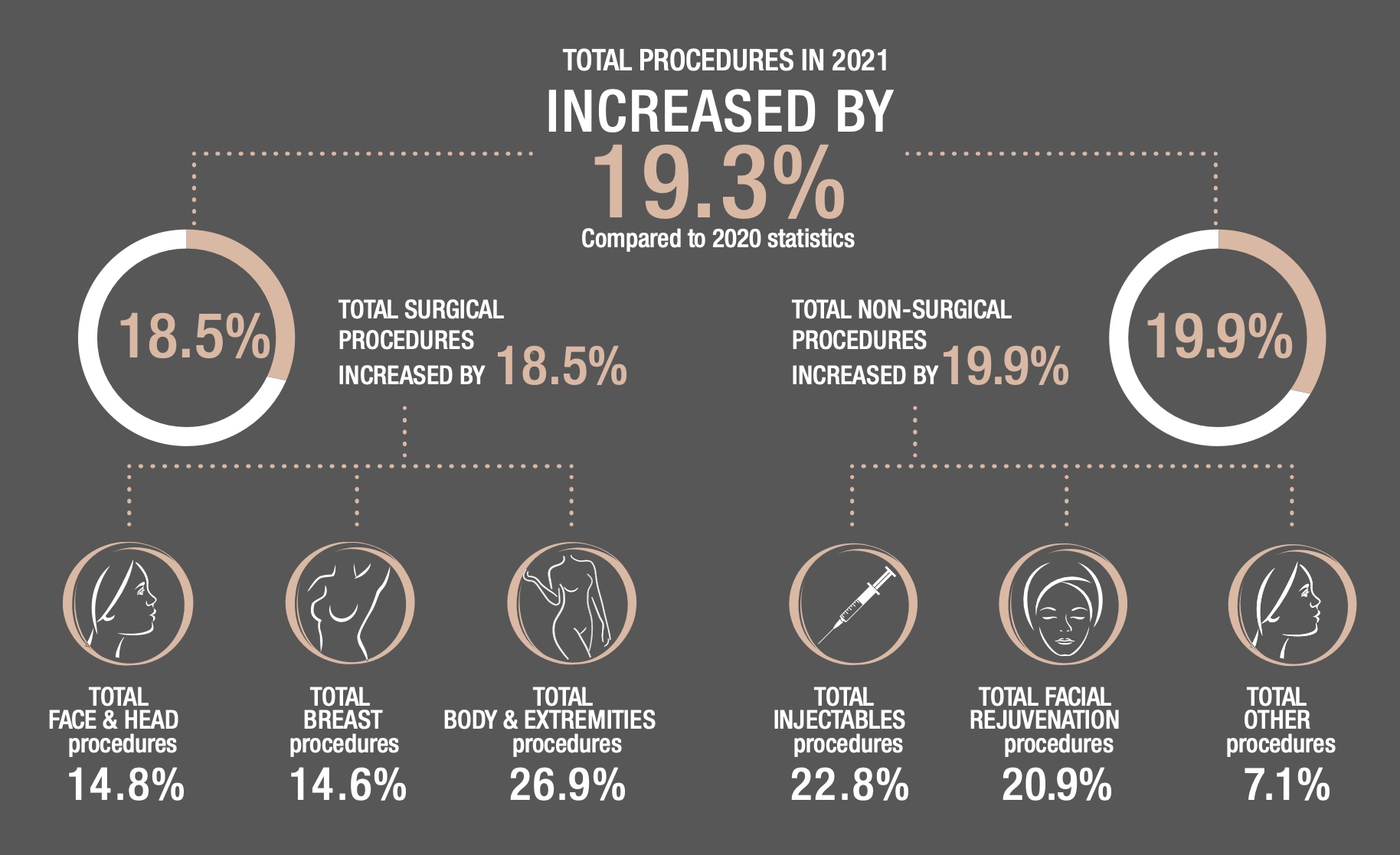New global survey results from the International Society of Aesthetic Plastic Surgery (ISAPS) reveals the most popular surgical and non-surgical cosmetic procedures from around the world.
In January 2023, the International Society of Aesthetic Plastic Surgery (ISAPS) released the results of its annual Global Survey on aesthetic procedures. Overall, there was a 19.3% increase in procedures performed since the last reporting period, with more than 12.8 million surgical and 17.5 million non-surgical procedures performed worldwide.
The report shows a continuing rise in aesthetic surgery, with a 33.3% increase over the past four years. Both surgical and non-surgical procedures increased since the last survey (18.5% and 19.9%, respectively), with a significant increase of 54.4% in non-surgical procedures in the past four years.
According to Dr Gianluca Campiglio, global survey editor and plastic surgeon in Italy, ‘We noticed an interesting increase in surgical procedures related to so-called “body contouring”, such as liposuction, which is now ranked as the most common procedure, ahead of breast augmentation for the first time in many years, and also a similar emerging trend for abdominoplasty, thigh lift and buttock augmentation.’
Most common cosmetic procedures
Liposuction was the most common cosmetic surgical procedure in 2021, with more than 1.9 million procedures and a 24.8% increase, overtaking breast augmentation (+3.8%). The top five most popular surgical procedures were liposuction, breast augmentation, eyelid surgery, rhinoplasty and abdominoplasty. The top five non-surgical procedures were botulinum toxin injections, hyaluronic acid fillers, hair removal, skin tightening and fat reduction.
While breast augmentation remains the most common surgical procedure for women, this procedure had only a slight increase of +0.5% in the past four years. By contrast, surgery to remove implants increased by 22.6% (+49.6% in the past four years), and breast lifts by 31.4% in the past year.
Top 5 surgical procedures worldwide
absolute numbers and changes compared to 2020
| 1. Liposuction | 1,903,063 procedures | +24.8% |
| 2. Breast Augmentation | 1,685,471 procedures | +3.8% |
| 3. Eyelid Surgery | 1,446,890 procedures | +18.1% |
| 4. Rhinoplasty | 995,149 procedures | +16.7% |
| 5. Abdominoplasty | 991,361 procedures | +29.5% |
Top 5 non-surgical procedures worldwide
absolute numbers and changes compared to 2020
| 1.Botulinum Toxin | 7,312,616 procedures | +17.7% |
| 2. Hyaluronic Acid | 5,279,344 procedures | +30.3% |
| 3. Hair Removal | 1,836,111 procedures | -0.1% |
| 4. Non-Surgical Skin Tightening | 1,003,731 procedures | N/A |
| 5. Non-Surgical Fat Reduction | 730,980 procedures | +30.4% |
Top 5 Procedures Worldwide – Surgical
Liposuction
Liposuction is a cosmetic surgical procedure that removes excess fat from certain areas of the body. It can provide significant improvements in body contour and appearance, which can boost self-confidence and improve overall quality of life.
The procedure is typically performed on areas where stubborn pockets of fat are resistant to diet and exercise, such as the abdomen, thighs, hips, buttocks, arms and chin.
Recovery time varies depending on the individual and the extent of the procedure, but most people can return to work and normal activities within a few days to a week.
While liposuction can provide significant improvements in body contour, it is not a substitute for a healthy diet and exercise. It is also important to note that liposuction is not a weight-loss procedure and is not suitable if you are are significantly overweight or obese.
Breast Augmentation
Breast augmentation, also known as augmentation mammoplasty, is a surgical procedure designed to increase the size and improve the shape of the breasts. The procedure involves placing breast implants beneath the breast tissue and/or chest muscle to enhance the size and improve the overall appearance of the breasts.
Breast augmentation is typically performed on women who are dissatisfied with the size or shape of their breasts, or who have lost breast volume due to weight loss, pregnancy or ageing.
The procedure can also be used to correct asymmetry or other breast deformities.
It is typically performed under general anaesthesia and may or may not require an overnight hospital stay. Recovery time varies depending on the individual and the extent of the procedure, but most people can return to work and normal activities within a week or two.
There are several different types of breast implants available, including saline, silicone and cohesive gel implants. The type of implant used will depend on your goals, preferences and anatomy. It is important to discuss the different options with a qualified surgeon to determine which type of implant is best for you.
Eyelid Surgery
Blepharoplasty, also known as eyelid surgery, is a cosmetic surgical procedure that is designed to improve the appearance of the eyelids. The procedure can be performed on the upper and/or lower eyelids, depending on your individual needs and goals.
Upper eyelid surgery, or upper blepharoplasty, involves removing excess skin and fat from the upper eyelids to create a more youthful, refreshed appearance. The procedure can also be used to correct drooping eyelids that may be interfering with vision.
Lower eyelid surgery, aka lower blepharoplasty, involves removing excess skin and fat from the lower eyelids to reduce the appearance of eye bags and wrinkles. The procedure can also be used to correct sagging lower eyelids that may be causing a tired or aged appearance.
Both upper and lower blepharoplasty are typically performed under local anesthesia with sedation or general anesthesia and can take anywhere from one to three hours depending on the extent of the procedure. Recovery time varies depending on the individual and the extent of the procedure, but most people can return to work and normal activities within a week.
Rhinoplasty
Rhinoplasty, also known as nose reshaping surgery, is a cosmetic surgical procedure designed to improve the appearance and/or function of the nose. The procedure involves reshaping the nose by modifying the bone and cartilage.
Rhinoplasty can be performed for a variety of reasons, including correcting a deviated septum, improving the appearance of the nose or correcting breathing problems. The procedure can address a variety of concerns, including a large or small nose, a crooked nose, a bump on the bridge of the nose, or a wide or upturned nasal tip.
The surgery is typically performed under general anaesthesia and can take anywhere from one to three+ hours depending on the extent of the procedure. Recovery time varies depending on the individual and the extent of the procedure, but most people can return to work within a week or two.
Abdominoplasty
Abdominoplasty, also known as a tummy tuck, is a cosmetic surgical procedure designed to improve the appearance of the abdomen. The procedure involves removing excess skin and fat from the abdomen, and tightening the muscles of the abdominal wall.
Abdominoplasty is typically performed on individuals who have excess skin or fat in the abdominal area that is resistant to diet and exercise, or who have experienced significant weight loss or pregnancy. The procedure can also be used to correct abdominal muscle separation, or diastasis recti.
The surgery is performed under general anaesthesia. Recovery time varies depending on the individual and the extent of the procedure, but most people can return to work and normal activities after two to four weeks.
During the procedure, incisions are made in the lower abdomen, and excess skin and fat are removed. The abdominal muscles are then tightened with sutures to create a flatter, more toned appearance.
Top 5 Procedures Worldwide – Non-Surgical
Botulinum Toxin
Botulinum toxin, also referred to as anti-wrinkle injections, is the most popular popular non-surgical cosmetic procedure worldwide. The treatment involves injecting small amounts of botulinum toxin into the muscles of the face, which causes them to relax and reduces the appearance of wrinkles and fine lines.
Botulinum toxin is most commonly used to treat wrinkles and fine lines on the forehead, between the eyebrows, and around the eyes (crow’s feet). It can also be used “off-label” to treat other areas of the face, such as the chin, jawline and neck.
The procedure only takes a few minutes to complete. The effects of the treatment start to appear around four days after treatment and last for three to four months, after which the procedure can be repeated as needed.
Hyaluronic Acid Fillers
Hyaluronic acid (HA) fillers are used to restore lost volume, smooth lines and soften creases, or enhance facial contours. They work by injecting a gel-like substance made from hyaluronic acid under the skin. This helps to plump up wrinkles, smooth lines, and restore volume to the face.
HA fillers are most commonly used to rejuvenate the face by augmenting the lips, cheeks, chin, and other areas. They can also be used to fill in wrinkles, fine lines and deep creases, and to restore volume to areas that have lost fullness due to ageing, weight loss or disease.
The procedure is typically performed in a doctor’s office and takes around 10 to 40 minutes, depending on the number of areas being treated. The effects of the treatment are immediate (keep in mind there will be some slight swelling), and there is no downtime required after the procedure.
The results can last anywhere from six months to over a year, depending on the type of filler used and its placement.
Hair Removal
Laser hair removal offers a popular, long-lasting solution to unwanted hair, with many people experiencing near- permanent hair reduction after a series of treatments.
During the procedure, a laser emits a light that is absorbed by the pigment (melanin) in the hair. The light energy is converted to heat, which damages the hair follicles that produce hairs.
Laser hair removal is most commonly used to remove hair from the face, legs, arms, underarms, bikini area, and other areas of the body. The procedure can take anywhere from a few minutes to an hour or more, depending on the size of the area being treated.
The number of treatments required to achieve the desired results can vary depending on the individual and the type and colour of the hair. Most people require multiple treatments, spaced several weeks apart, to achieve long-lasting hair reduction, after which a maintenance treatment every six months or so is recommended.
Non-Surgical Skin Tightening
Non-surgical skin tightening is a procedure that uses a type of energy, such as radiofrequency, ultrasound or laser, to tighten and firm the skin without the need for surgery. These devices work by delivering energy to the deeper layers of the skin, which stimulates collagen production and tightens the skin.
Some of the most common skin tightening devices in Australia use radiofrequency technology and ultrasound energy to target the skin’s deeper dermis and subcutaneous layers, tightening the underlying tissue structure without damaging the outer layers of skin. This heating of the deep dermis and sub-dermal layers of the skin damages collagen in a controlled way, causing instant collagen contraction and promoting the body’s own healing mechanisms to produce new collagen over the ensuing months.
A non-surgical skin tightening procedure is commonly used to lift the brow and forehead, around the eyes, cheeks and mid-face, jaw line and neck. This type of treatment is best suited for patients with mild to moderate sagging facial tissues, and can be used on any skin colour. It is not suitable for those with more extensive loose skin.
Results are typically long-lasting, depending on the patient’s skin condition and severity of facial ageing and usually only one treatment is required.
Non-Surgical Fat Reduction
Non-surgical body contouring procedures use medical-grade energy-based devices to permanently destroy fat cells. The energy is emitted via an applicator through the skin without damaging the outer layers or surrounding tissues, only targeting the unwanted fat.
Most of these devices use radiofrequency, ultrasound or laser energy to disrupt fat cells. Regardless of the type of energy used, they all work to break down the fat cells, which are then naturally metabolised by the body over the following weeks.
Non-surgical fat reduction is most commonly used to treat areas of stubborn fat on the abdomen, hips, thighs, back, knees, arms, under the chin and other areas of the body. The procedure is comfortable for most people and can take anywhere from 20 minutes to an hour, depending on the size of the area and number of areas being treated.
Most non-surgical devices require a series of treatments to achieve best possible results. There is normally no downtime and complications are rare. In conjunction with a healthy diet and exercise, results should be long lasting because, just as with liposuction, when fat cells are permanently destroyed they will not return. [A]A














